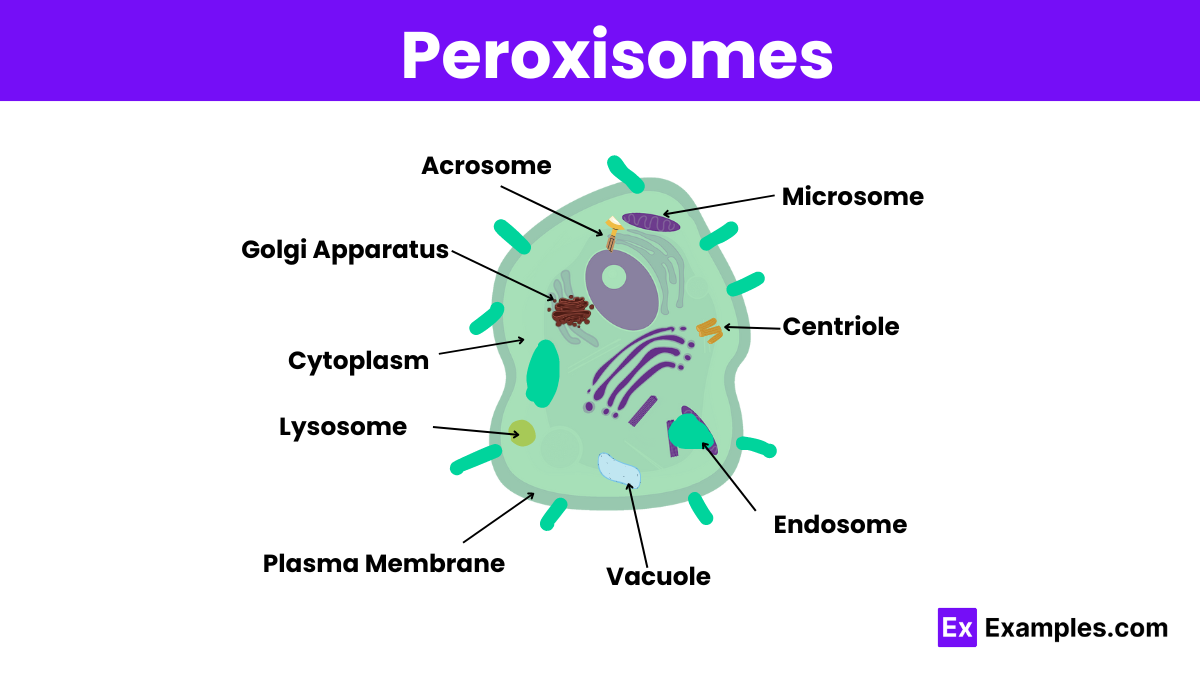What is the primary function of peroxisomes in a cell?
Protein synthesis
Lipid metabolism
DNA replication
Cellular respiration


Venture into the microscopic world of peroxisomes, the versatile organelles critical for cellular health and metabolism. This guide unravels the complex roles of peroxisomes, from breaking down fatty acids and detoxifying harmful substances to synthesizing vital lipids. Through detailed examples, we illustrate how these small but powerful components of the cell work tirelessly to protect and maintain cellular balance. Ideal for students, educators, and anyone fascinated by the inner workings of cells, this guide offers a comprehensive look at peroxisomes, shining a light on their essential functions in sustaining life.
Peroxisomes are small, membrane-bound organelles present in virtually all eukaryotic cells. They play a critical role in cellular metabolism, particularly in the breakdown of very long-chain fatty acids through β-oxidation, the detoxification of hydrogen peroxide (H2O2), and the metabolism of certain biomolecules. Peroxisomes contain enzymes that catalyze these chemical reactions, converting harmful substances into harmless products. For example, the enzyme catalase, which is abundant in peroxisomes, breaks down hydrogen peroxide—a byproduct of cellular metabolism that can be damaging to the cell—into water and oxygen.
Peroxisomes are small, membrane-bound organelles present in the cytoplasm of virtually all eukaryotic cells. They are involved in various metabolic processes, particularly those related to lipid metabolism and the detoxification of harmful substances. Structurally, peroxisomes are similar to lysosomes but are distinguished by their content and function. The key structural features of peroxisomes include:
Peroxisomes are capable of increasing in number through both division and de novo synthesis, adapting to the metabolic needs of the cell.
Peroxisomes play several crucial roles in cellular metabolism:
Peroxisomes are dynamic organelles that contribute to various aspects of cellular metabolism, including:
Peroxisomes are small, membrane-bound organelles found in virtually all eukaryotic cells. They are involved in a variety of metabolic processes, notably the breakdown of very long chain fatty acids through beta-oxidation, the detoxification of hydrogen peroxide (H₂O₂), and the metabolism of reactive oxygen species (ROS).
Peroxisomes and lysosomes are both membrane-bound organelles in eukaryotic cells, but they have distinct structures, functions, and origins, serving different roles in cellular metabolism and maintenance.
Peroxisomes are located in the cytoplasm of almost all eukaryotic cells, where they perform essential metabolic functions.
The liver contains more peroxisomes than any other organ, reflecting its key role in detoxifying substances and metabolism
Peroxisomes play a pivotal role in cellular metabolism, notably in detoxifying hydrogen peroxide and breaking down fatty acids. Their adaptability in quantity and functionality to meet metabolic demands underscores their critical contribution to cellular health, particularly in detoxification processes and oxidative stress response. This highlights the organelle’s significance in maintaining metabolic equilibrium and safeguarding cellular integrity.
Text prompt
Add Tone
10 Examples of Public speaking
20 Examples of Gas lighting
What is the primary function of peroxisomes in a cell?
Protein synthesis
Lipid metabolism
DNA replication
Cellular respiration
Which enzyme is primarily found in peroxisomes and is crucial for their function?
DNA polymerase
Catalase
RNA polymerase
ATP synthase
What type of molecules do peroxisomes help detoxify in the cell?
Amino acids
Sugars
Lipids
Reactive oxygen species
Peroxisomes are similar to mitochondria in which aspect?
Both have a double membrane
Both are involved in protein synthesis
Both store genetic information
Both are involved in lipid metabolism
Which of the following is a common disorder associated with peroxisome dysfunction?
Cystic fibrosis
Tay-Sachs disease
Zellweger syndrome
Huntington's disease
What role do peroxisomes play in relation to hydrogen peroxide?
They produce hydrogen peroxide
They store hydrogen peroxide
They decompose hydrogen peroxide
They transport hydrogen peroxide
How are peroxisomes formed within the cell?
By budding off the endoplasmic reticulum
By budding off the Golgi apparatus
By splitting from mitochondria
By fusion with lysosomes
In which type of cells are peroxisomes particularly abundant?
Muscle cells
Nerve cells
Liver cells
Red blood cells
What is a key structural feature of peroxisomes that distinguishes them from other organelles?
A single membrane
A double membrane
No membrane
A unique ribosomal coating
Which of the following processes is NOT associated with peroxisomes?
Beta-oxidation of fatty acids
Breakdown of hydrogen peroxide
Synthesis of cholesterol
Conversion of purines to uric acid
Before you leave, take our quick quiz to enhance your learning!

